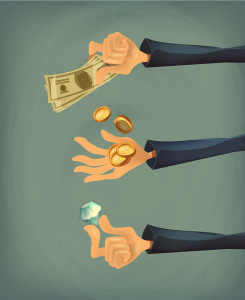Beware of jewelry deals that are too good to be true
Beware of jewelry deals that are too good to be true.
By Scott Bohall
For those who don’t know three-card Monte, it’s the game you see on the streets of New York where the object is to watch a dealer arrange three playing cards back and forth until you are confused enough to select the wrong card. The problem is that the queen you are supposed to find is actually not any of the three cards. A sleight-of-hand gesture shows it to you, but then it ends up in the pocket of the dealer. In other words, the game is rigged.
The February Valentine’s season is among the many times of year that fraud in the jewelry industry is rampant. Be careful and use your brain to make sure you are not duped. Often these “deals” show up on Facebook ads or computer pop-ups. I just let Groupon know that they are offering deals that are not even close to what they represent. Two-carat ruby earrings for $7––that should be enough to let you know something is wrong. They are supposedly worth $250 but today “only” they are reduced by $243. They sold 5,000 pair. Let me tell you, there are not enough rubies in the world to supply any of us with 5,000 pairs of one carat each of the same quality. First, the earrings are not genuine, natural ruby as promised; they are treated junk. For $7 what do you expect? Additionally, they’re not worth the $250 stated value. Sadly, even though there are laws to protect consumers, enforcement rarely happens.
The second promotion that popped up recently advertised 18k white gold rings for $50 each with lots of stones in them. It’s very hard to find the fine print that divulges that the rings are silver with white gold plating and the stones are not real. The challenge is that the fine print has to be searched for, while the title leads you to believe that they are $1,000 rings for $50. That is fraud, plain and simple.
It’s not just the low-price customers that get burned this time of year. A customer just brought us a diamond-and-alexandrite ring with certificates and appraisals from a laboratory in Beverly Hills. The laboratory does not exist and the person who is listed as the appraiser has neither a gemology degree nor an appraisal degree. The alexandrite is actually chrysoberyl, which is the same gem family but without the classic color change. The value was supposed to be $19,000, she paid only $6,000, but the ring is truly worth around $2,000.
Jewelry can be the best and most romantic Valentine’s gift anyone gets or a complete waste of money. If you don’t know jewelry, know your jeweler.
The 5 Biggest Diamond-Buyer Mistakes
- Assuming all diamonds of the same color, clarity, and cut grade are the same
- Assuming everything you need to know about a diamond is on the certificate, and that a diamond can be purchased “by the numbers” alone
- Assuming everyone selling diamonds is a GIA Graduate Gemologist
- Assuming laboratory grading is always accurate and uniform to industry standards
- Assuming color and clarity are the major determinants in pricing a diamond
Related posts
Leave a Comment
You must be logged in to post a comment.







